Analyzing Alcoholism in Low Socioeconomic White Men: A Case Study
VerifiedAdded on 2022/12/29
|11
|3604
|2
Case Study
AI Summary
This case study delves into the pervasive issue of alcoholism among low socioeconomic white men, utilizing William Kennedy's novel 'Ironweed' as a focal point to examine vulnerability and health disparities. The study highlights the significant burden of alcohol consumption on global populations, emphasizing its direct impact on financial stability and socioeconomic well-being. It explores the correlation between lower socioeconomic status and increased alcohol dependence, referencing epidemiological data and research findings. The case study examines the impact of binge drinking, the role of social and environmental factors, and the influence of family history on alcohol abuse. Furthermore, it discusses the health consequences of alcoholism, including various cancers, stroke, and liver disease, while also considering the role of nursing interventions, such as brief interventions and the FRAMES guideline, in addressing this critical issue.
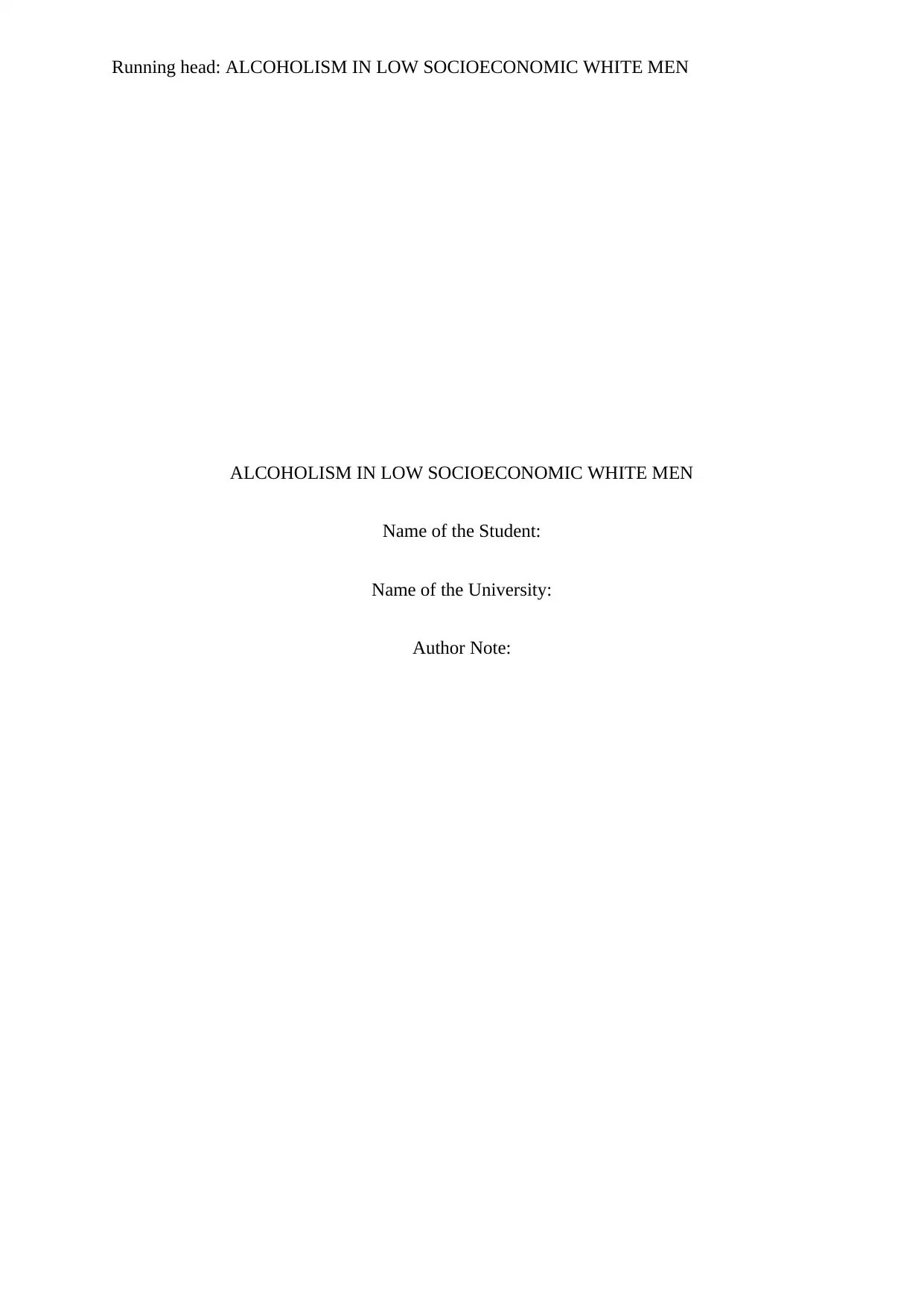
Running head: ALCOHOLISM IN LOW SOCIOECONOMIC WHITE MEN
ALCOHOLISM IN LOW SOCIOECONOMIC WHITE MEN
Name of the Student:
Name of the University:
Author Note:
ALCOHOLISM IN LOW SOCIOECONOMIC WHITE MEN
Name of the Student:
Name of the University:
Author Note:
Paraphrase This Document
Need a fresh take? Get an instant paraphrase of this document with our AI Paraphraser
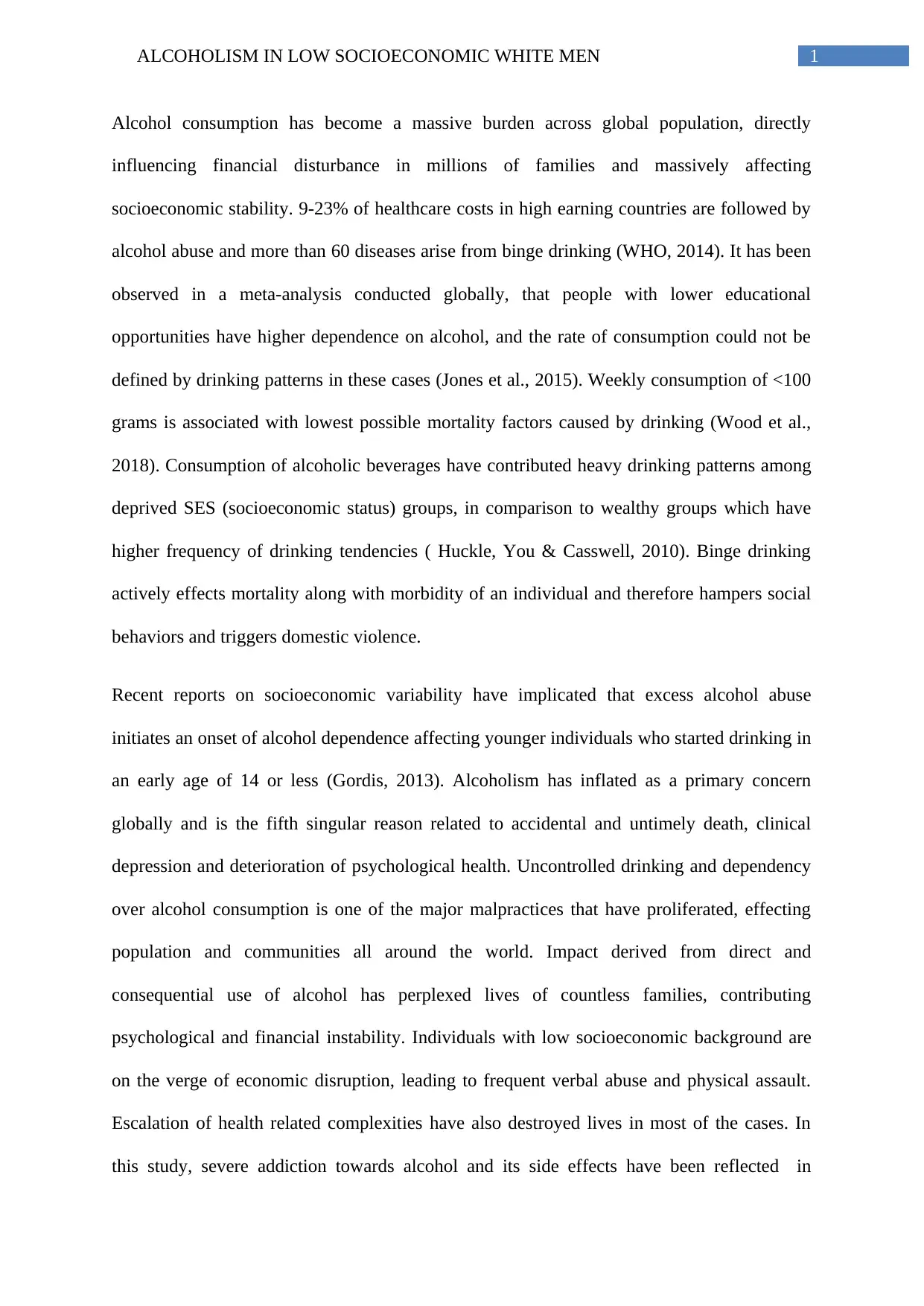
1ALCOHOLISM IN LOW SOCIOECONOMIC WHITE MEN
Alcohol consumption has become a massive burden across global population, directly
influencing financial disturbance in millions of families and massively affecting
socioeconomic stability. 9-23% of healthcare costs in high earning countries are followed by
alcohol abuse and more than 60 diseases arise from binge drinking (WHO, 2014). It has been
observed in a meta-analysis conducted globally, that people with lower educational
opportunities have higher dependence on alcohol, and the rate of consumption could not be
defined by drinking patterns in these cases (Jones et al., 2015). Weekly consumption of <100
grams is associated with lowest possible mortality factors caused by drinking (Wood et al.,
2018). Consumption of alcoholic beverages have contributed heavy drinking patterns among
deprived SES (socioeconomic status) groups, in comparison to wealthy groups which have
higher frequency of drinking tendencies ( Huckle, You & Casswell, 2010). Binge drinking
actively effects mortality along with morbidity of an individual and therefore hampers social
behaviors and triggers domestic violence.
Recent reports on socioeconomic variability have implicated that excess alcohol abuse
initiates an onset of alcohol dependence affecting younger individuals who started drinking in
an early age of 14 or less (Gordis, 2013). Alcoholism has inflated as a primary concern
globally and is the fifth singular reason related to accidental and untimely death, clinical
depression and deterioration of psychological health. Uncontrolled drinking and dependency
over alcohol consumption is one of the major malpractices that have proliferated, effecting
population and communities all around the world. Impact derived from direct and
consequential use of alcohol has perplexed lives of countless families, contributing
psychological and financial instability. Individuals with low socioeconomic background are
on the verge of economic disruption, leading to frequent verbal abuse and physical assault.
Escalation of health related complexities have also destroyed lives in most of the cases. In
this study, severe addiction towards alcohol and its side effects have been reflected in
Alcohol consumption has become a massive burden across global population, directly
influencing financial disturbance in millions of families and massively affecting
socioeconomic stability. 9-23% of healthcare costs in high earning countries are followed by
alcohol abuse and more than 60 diseases arise from binge drinking (WHO, 2014). It has been
observed in a meta-analysis conducted globally, that people with lower educational
opportunities have higher dependence on alcohol, and the rate of consumption could not be
defined by drinking patterns in these cases (Jones et al., 2015). Weekly consumption of <100
grams is associated with lowest possible mortality factors caused by drinking (Wood et al.,
2018). Consumption of alcoholic beverages have contributed heavy drinking patterns among
deprived SES (socioeconomic status) groups, in comparison to wealthy groups which have
higher frequency of drinking tendencies ( Huckle, You & Casswell, 2010). Binge drinking
actively effects mortality along with morbidity of an individual and therefore hampers social
behaviors and triggers domestic violence.
Recent reports on socioeconomic variability have implicated that excess alcohol abuse
initiates an onset of alcohol dependence affecting younger individuals who started drinking in
an early age of 14 or less (Gordis, 2013). Alcoholism has inflated as a primary concern
globally and is the fifth singular reason related to accidental and untimely death, clinical
depression and deterioration of psychological health. Uncontrolled drinking and dependency
over alcohol consumption is one of the major malpractices that have proliferated, effecting
population and communities all around the world. Impact derived from direct and
consequential use of alcohol has perplexed lives of countless families, contributing
psychological and financial instability. Individuals with low socioeconomic background are
on the verge of economic disruption, leading to frequent verbal abuse and physical assault.
Escalation of health related complexities have also destroyed lives in most of the cases. In
this study, severe addiction towards alcohol and its side effects have been reflected in
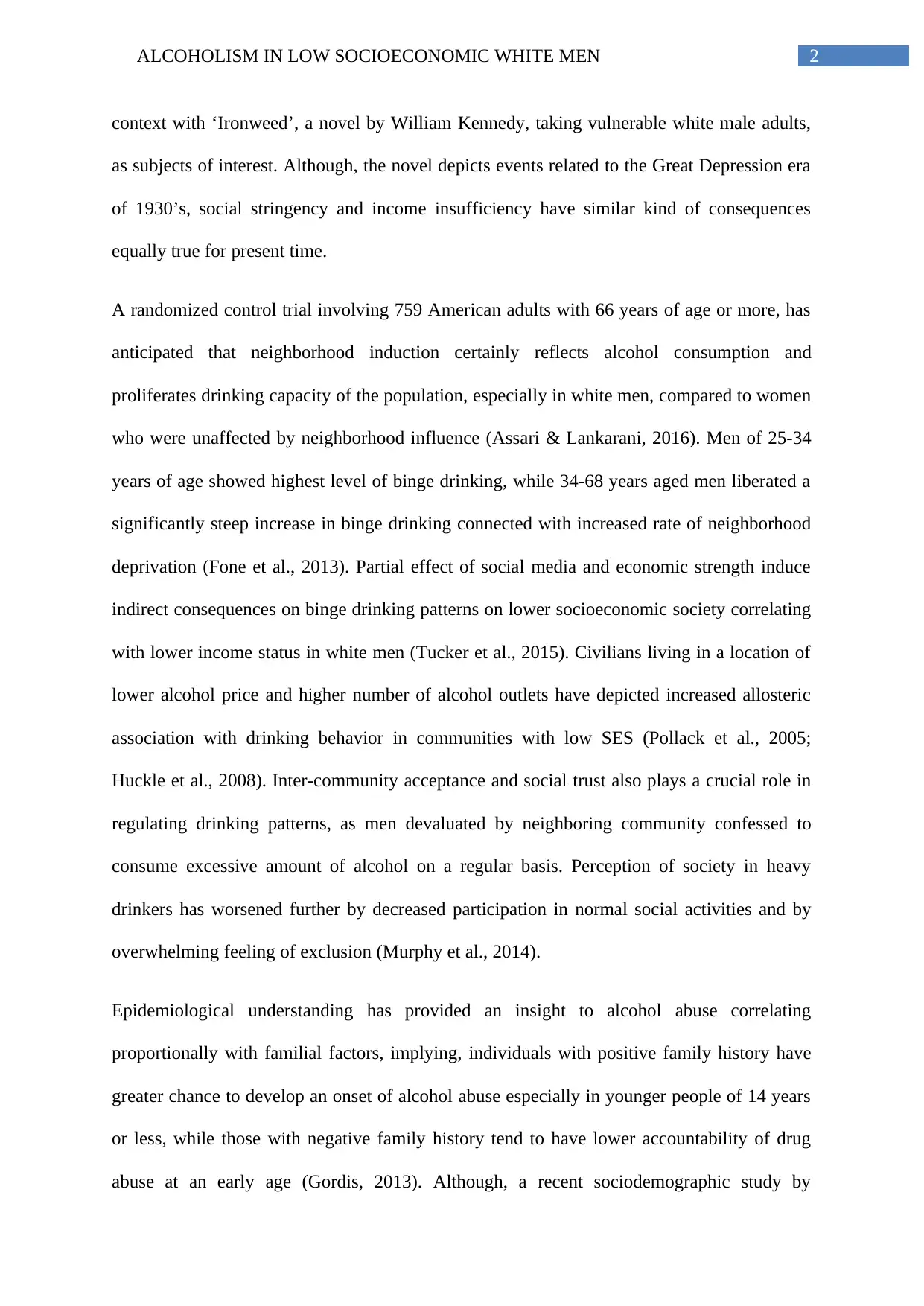
2ALCOHOLISM IN LOW SOCIOECONOMIC WHITE MEN
context with ‘Ironweed’, a novel by William Kennedy, taking vulnerable white male adults,
as subjects of interest. Although, the novel depicts events related to the Great Depression era
of 1930’s, social stringency and income insufficiency have similar kind of consequences
equally true for present time.
A randomized control trial involving 759 American adults with 66 years of age or more, has
anticipated that neighborhood induction certainly reflects alcohol consumption and
proliferates drinking capacity of the population, especially in white men, compared to women
who were unaffected by neighborhood influence (Assari & Lankarani, 2016). Men of 25-34
years of age showed highest level of binge drinking, while 34-68 years aged men liberated a
significantly steep increase in binge drinking connected with increased rate of neighborhood
deprivation (Fone et al., 2013). Partial effect of social media and economic strength induce
indirect consequences on binge drinking patterns on lower socioeconomic society correlating
with lower income status in white men (Tucker et al., 2015). Civilians living in a location of
lower alcohol price and higher number of alcohol outlets have depicted increased allosteric
association with drinking behavior in communities with low SES (Pollack et al., 2005;
Huckle et al., 2008). Inter-community acceptance and social trust also plays a crucial role in
regulating drinking patterns, as men devaluated by neighboring community confessed to
consume excessive amount of alcohol on a regular basis. Perception of society in heavy
drinkers has worsened further by decreased participation in normal social activities and by
overwhelming feeling of exclusion (Murphy et al., 2014).
Epidemiological understanding has provided an insight to alcohol abuse correlating
proportionally with familial factors, implying, individuals with positive family history have
greater chance to develop an onset of alcohol abuse especially in younger people of 14 years
or less, while those with negative family history tend to have lower accountability of drug
abuse at an early age (Gordis, 2013). Although, a recent sociodemographic study by
context with ‘Ironweed’, a novel by William Kennedy, taking vulnerable white male adults,
as subjects of interest. Although, the novel depicts events related to the Great Depression era
of 1930’s, social stringency and income insufficiency have similar kind of consequences
equally true for present time.
A randomized control trial involving 759 American adults with 66 years of age or more, has
anticipated that neighborhood induction certainly reflects alcohol consumption and
proliferates drinking capacity of the population, especially in white men, compared to women
who were unaffected by neighborhood influence (Assari & Lankarani, 2016). Men of 25-34
years of age showed highest level of binge drinking, while 34-68 years aged men liberated a
significantly steep increase in binge drinking connected with increased rate of neighborhood
deprivation (Fone et al., 2013). Partial effect of social media and economic strength induce
indirect consequences on binge drinking patterns on lower socioeconomic society correlating
with lower income status in white men (Tucker et al., 2015). Civilians living in a location of
lower alcohol price and higher number of alcohol outlets have depicted increased allosteric
association with drinking behavior in communities with low SES (Pollack et al., 2005;
Huckle et al., 2008). Inter-community acceptance and social trust also plays a crucial role in
regulating drinking patterns, as men devaluated by neighboring community confessed to
consume excessive amount of alcohol on a regular basis. Perception of society in heavy
drinkers has worsened further by decreased participation in normal social activities and by
overwhelming feeling of exclusion (Murphy et al., 2014).
Epidemiological understanding has provided an insight to alcohol abuse correlating
proportionally with familial factors, implying, individuals with positive family history have
greater chance to develop an onset of alcohol abuse especially in younger people of 14 years
or less, while those with negative family history tend to have lower accountability of drug
abuse at an early age (Gordis, 2013). Although, a recent sociodemographic study by
⊘ This is a preview!⊘
Do you want full access?
Subscribe today to unlock all pages.

Trusted by 1+ million students worldwide
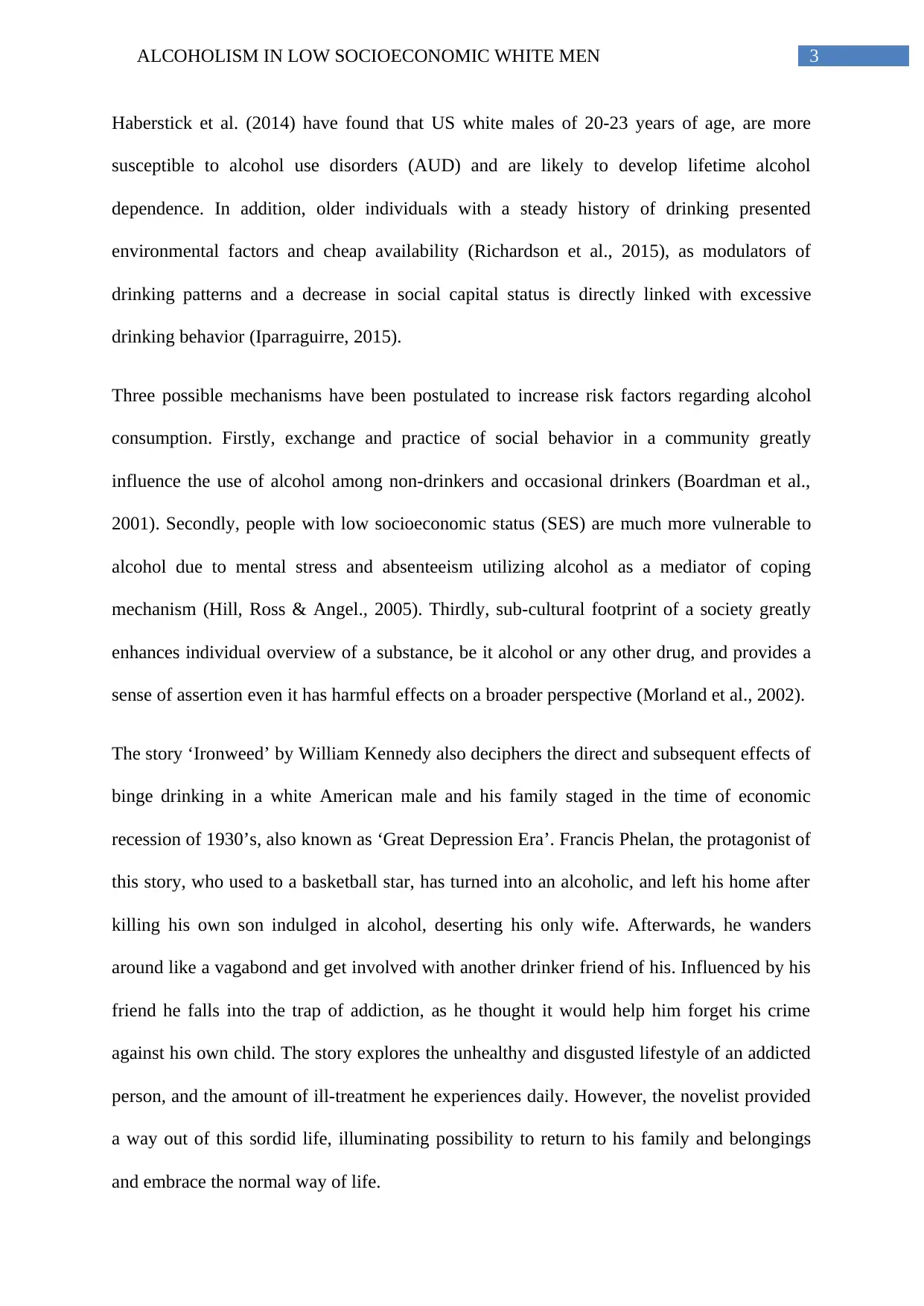
3ALCOHOLISM IN LOW SOCIOECONOMIC WHITE MEN
Haberstick et al. (2014) have found that US white males of 20-23 years of age, are more
susceptible to alcohol use disorders (AUD) and are likely to develop lifetime alcohol
dependence. In addition, older individuals with a steady history of drinking presented
environmental factors and cheap availability (Richardson et al., 2015), as modulators of
drinking patterns and a decrease in social capital status is directly linked with excessive
drinking behavior (Iparraguirre, 2015).
Three possible mechanisms have been postulated to increase risk factors regarding alcohol
consumption. Firstly, exchange and practice of social behavior in a community greatly
influence the use of alcohol among non-drinkers and occasional drinkers (Boardman et al.,
2001). Secondly, people with low socioeconomic status (SES) are much more vulnerable to
alcohol due to mental stress and absenteeism utilizing alcohol as a mediator of coping
mechanism (Hill, Ross & Angel., 2005). Thirdly, sub-cultural footprint of a society greatly
enhances individual overview of a substance, be it alcohol or any other drug, and provides a
sense of assertion even it has harmful effects on a broader perspective (Morland et al., 2002).
The story ‘Ironweed’ by William Kennedy also deciphers the direct and subsequent effects of
binge drinking in a white American male and his family staged in the time of economic
recession of 1930’s, also known as ‘Great Depression Era’. Francis Phelan, the protagonist of
this story, who used to a basketball star, has turned into an alcoholic, and left his home after
killing his own son indulged in alcohol, deserting his only wife. Afterwards, he wanders
around like a vagabond and get involved with another drinker friend of his. Influenced by his
friend he falls into the trap of addiction, as he thought it would help him forget his crime
against his own child. The story explores the unhealthy and disgusted lifestyle of an addicted
person, and the amount of ill-treatment he experiences daily. However, the novelist provided
a way out of this sordid life, illuminating possibility to return to his family and belongings
and embrace the normal way of life.
Haberstick et al. (2014) have found that US white males of 20-23 years of age, are more
susceptible to alcohol use disorders (AUD) and are likely to develop lifetime alcohol
dependence. In addition, older individuals with a steady history of drinking presented
environmental factors and cheap availability (Richardson et al., 2015), as modulators of
drinking patterns and a decrease in social capital status is directly linked with excessive
drinking behavior (Iparraguirre, 2015).
Three possible mechanisms have been postulated to increase risk factors regarding alcohol
consumption. Firstly, exchange and practice of social behavior in a community greatly
influence the use of alcohol among non-drinkers and occasional drinkers (Boardman et al.,
2001). Secondly, people with low socioeconomic status (SES) are much more vulnerable to
alcohol due to mental stress and absenteeism utilizing alcohol as a mediator of coping
mechanism (Hill, Ross & Angel., 2005). Thirdly, sub-cultural footprint of a society greatly
enhances individual overview of a substance, be it alcohol or any other drug, and provides a
sense of assertion even it has harmful effects on a broader perspective (Morland et al., 2002).
The story ‘Ironweed’ by William Kennedy also deciphers the direct and subsequent effects of
binge drinking in a white American male and his family staged in the time of economic
recession of 1930’s, also known as ‘Great Depression Era’. Francis Phelan, the protagonist of
this story, who used to a basketball star, has turned into an alcoholic, and left his home after
killing his own son indulged in alcohol, deserting his only wife. Afterwards, he wanders
around like a vagabond and get involved with another drinker friend of his. Influenced by his
friend he falls into the trap of addiction, as he thought it would help him forget his crime
against his own child. The story explores the unhealthy and disgusted lifestyle of an addicted
person, and the amount of ill-treatment he experiences daily. However, the novelist provided
a way out of this sordid life, illuminating possibility to return to his family and belongings
and embrace the normal way of life.
Paraphrase This Document
Need a fresh take? Get an instant paraphrase of this document with our AI Paraphraser
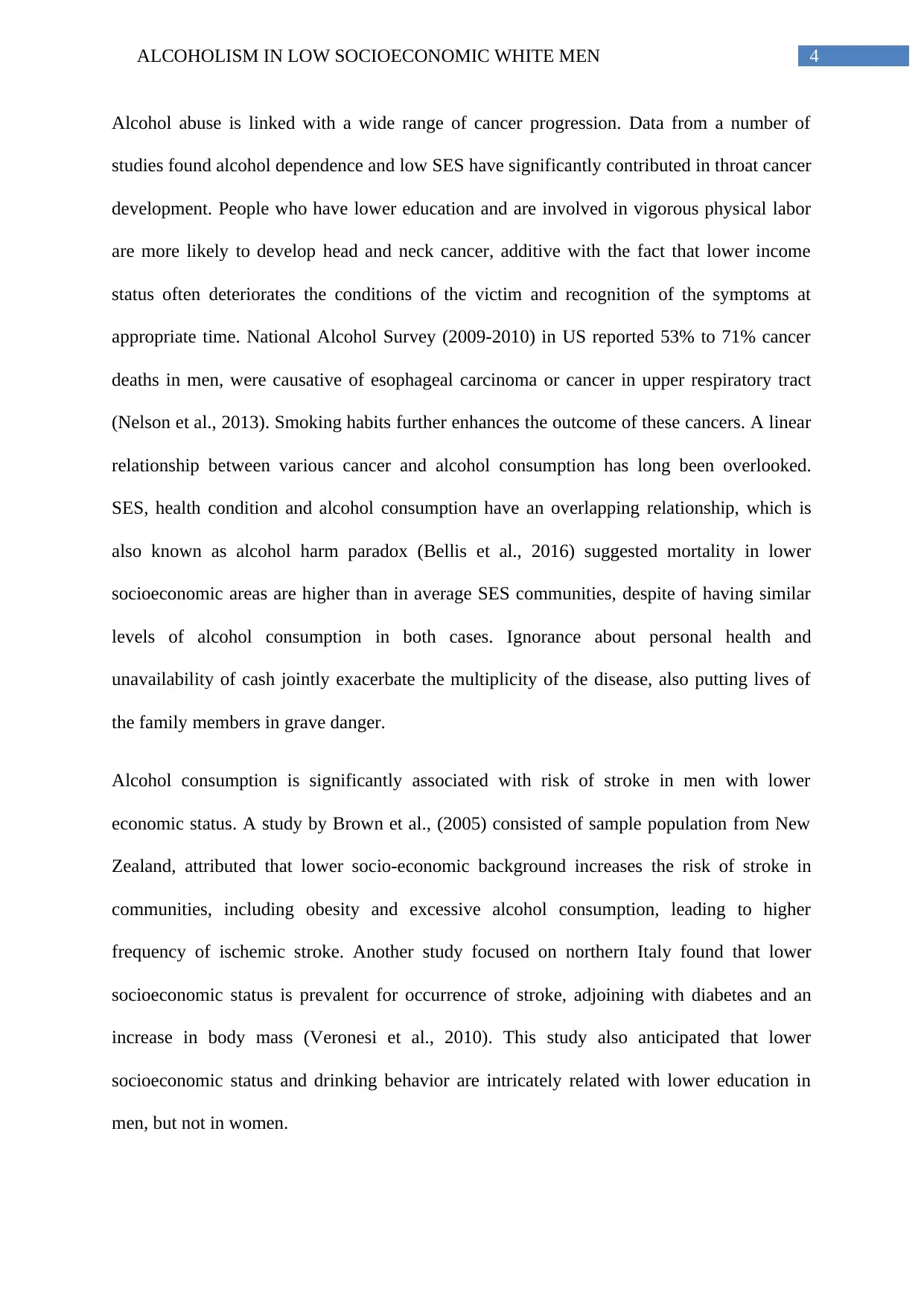
4ALCOHOLISM IN LOW SOCIOECONOMIC WHITE MEN
Alcohol abuse is linked with a wide range of cancer progression. Data from a number of
studies found alcohol dependence and low SES have significantly contributed in throat cancer
development. People who have lower education and are involved in vigorous physical labor
are more likely to develop head and neck cancer, additive with the fact that lower income
status often deteriorates the conditions of the victim and recognition of the symptoms at
appropriate time. National Alcohol Survey (2009-2010) in US reported 53% to 71% cancer
deaths in men, were causative of esophageal carcinoma or cancer in upper respiratory tract
(Nelson et al., 2013). Smoking habits further enhances the outcome of these cancers. A linear
relationship between various cancer and alcohol consumption has long been overlooked.
SES, health condition and alcohol consumption have an overlapping relationship, which is
also known as alcohol harm paradox (Bellis et al., 2016) suggested mortality in lower
socioeconomic areas are higher than in average SES communities, despite of having similar
levels of alcohol consumption in both cases. Ignorance about personal health and
unavailability of cash jointly exacerbate the multiplicity of the disease, also putting lives of
the family members in grave danger.
Alcohol consumption is significantly associated with risk of stroke in men with lower
economic status. A study by Brown et al., (2005) consisted of sample population from New
Zealand, attributed that lower socio-economic background increases the risk of stroke in
communities, including obesity and excessive alcohol consumption, leading to higher
frequency of ischemic stroke. Another study focused on northern Italy found that lower
socioeconomic status is prevalent for occurrence of stroke, adjoining with diabetes and an
increase in body mass (Veronesi et al., 2010). This study also anticipated that lower
socioeconomic status and drinking behavior are intricately related with lower education in
men, but not in women.
Alcohol abuse is linked with a wide range of cancer progression. Data from a number of
studies found alcohol dependence and low SES have significantly contributed in throat cancer
development. People who have lower education and are involved in vigorous physical labor
are more likely to develop head and neck cancer, additive with the fact that lower income
status often deteriorates the conditions of the victim and recognition of the symptoms at
appropriate time. National Alcohol Survey (2009-2010) in US reported 53% to 71% cancer
deaths in men, were causative of esophageal carcinoma or cancer in upper respiratory tract
(Nelson et al., 2013). Smoking habits further enhances the outcome of these cancers. A linear
relationship between various cancer and alcohol consumption has long been overlooked.
SES, health condition and alcohol consumption have an overlapping relationship, which is
also known as alcohol harm paradox (Bellis et al., 2016) suggested mortality in lower
socioeconomic areas are higher than in average SES communities, despite of having similar
levels of alcohol consumption in both cases. Ignorance about personal health and
unavailability of cash jointly exacerbate the multiplicity of the disease, also putting lives of
the family members in grave danger.
Alcohol consumption is significantly associated with risk of stroke in men with lower
economic status. A study by Brown et al., (2005) consisted of sample population from New
Zealand, attributed that lower socio-economic background increases the risk of stroke in
communities, including obesity and excessive alcohol consumption, leading to higher
frequency of ischemic stroke. Another study focused on northern Italy found that lower
socioeconomic status is prevalent for occurrence of stroke, adjoining with diabetes and an
increase in body mass (Veronesi et al., 2010). This study also anticipated that lower
socioeconomic status and drinking behavior are intricately related with lower education in
men, but not in women.
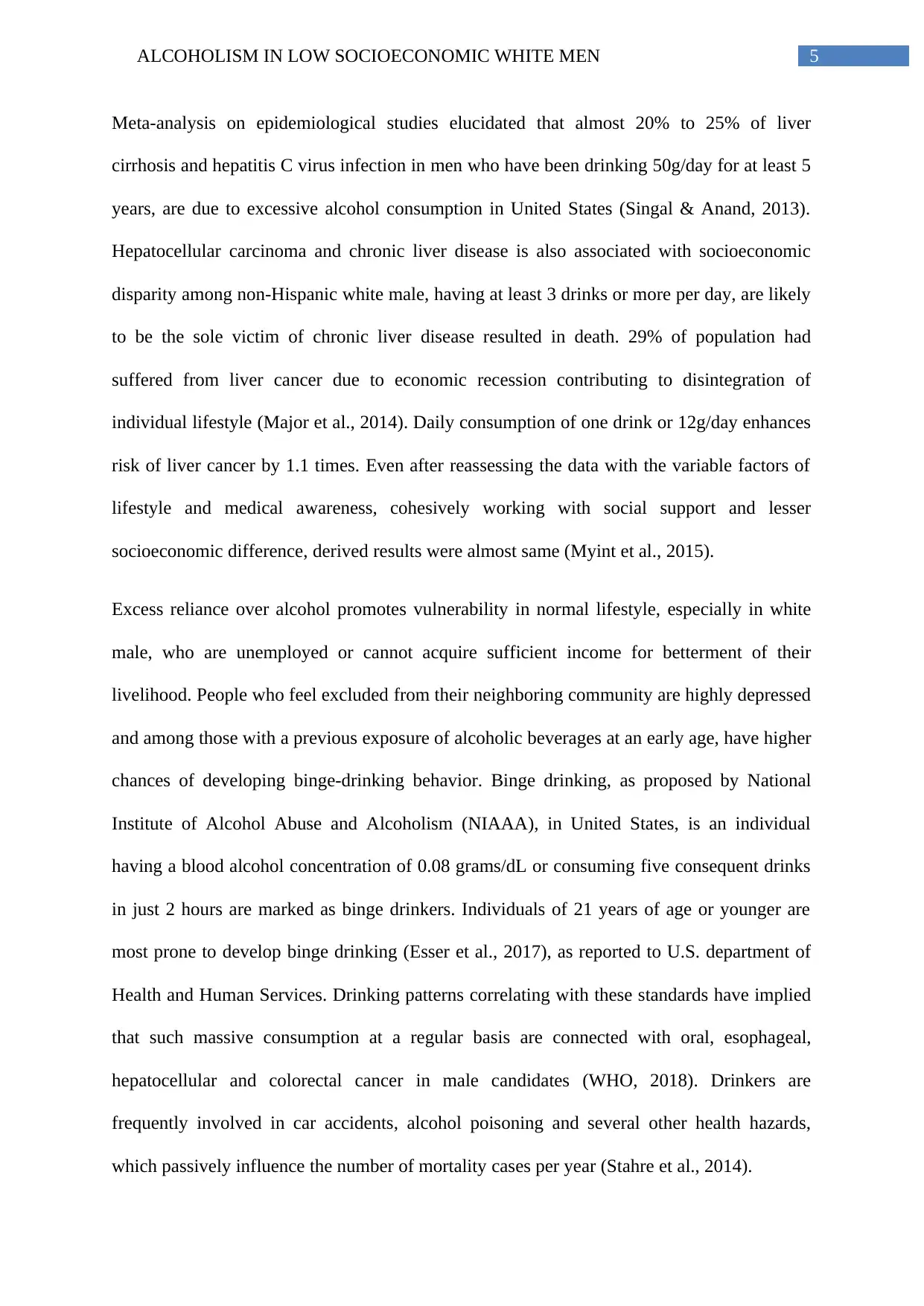
5ALCOHOLISM IN LOW SOCIOECONOMIC WHITE MEN
Meta-analysis on epidemiological studies elucidated that almost 20% to 25% of liver
cirrhosis and hepatitis C virus infection in men who have been drinking 50g/day for at least 5
years, are due to excessive alcohol consumption in United States (Singal & Anand, 2013).
Hepatocellular carcinoma and chronic liver disease is also associated with socioeconomic
disparity among non-Hispanic white male, having at least 3 drinks or more per day, are likely
to be the sole victim of chronic liver disease resulted in death. 29% of population had
suffered from liver cancer due to economic recession contributing to disintegration of
individual lifestyle (Major et al., 2014). Daily consumption of one drink or 12g/day enhances
risk of liver cancer by 1.1 times. Even after reassessing the data with the variable factors of
lifestyle and medical awareness, cohesively working with social support and lesser
socioeconomic difference, derived results were almost same (Myint et al., 2015).
Excess reliance over alcohol promotes vulnerability in normal lifestyle, especially in white
male, who are unemployed or cannot acquire sufficient income for betterment of their
livelihood. People who feel excluded from their neighboring community are highly depressed
and among those with a previous exposure of alcoholic beverages at an early age, have higher
chances of developing binge-drinking behavior. Binge drinking, as proposed by National
Institute of Alcohol Abuse and Alcoholism (NIAAA), in United States, is an individual
having a blood alcohol concentration of 0.08 grams/dL or consuming five consequent drinks
in just 2 hours are marked as binge drinkers. Individuals of 21 years of age or younger are
most prone to develop binge drinking (Esser et al., 2017), as reported to U.S. department of
Health and Human Services. Drinking patterns correlating with these standards have implied
that such massive consumption at a regular basis are connected with oral, esophageal,
hepatocellular and colorectal cancer in male candidates (WHO, 2018). Drinkers are
frequently involved in car accidents, alcohol poisoning and several other health hazards,
which passively influence the number of mortality cases per year (Stahre et al., 2014).
Meta-analysis on epidemiological studies elucidated that almost 20% to 25% of liver
cirrhosis and hepatitis C virus infection in men who have been drinking 50g/day for at least 5
years, are due to excessive alcohol consumption in United States (Singal & Anand, 2013).
Hepatocellular carcinoma and chronic liver disease is also associated with socioeconomic
disparity among non-Hispanic white male, having at least 3 drinks or more per day, are likely
to be the sole victim of chronic liver disease resulted in death. 29% of population had
suffered from liver cancer due to economic recession contributing to disintegration of
individual lifestyle (Major et al., 2014). Daily consumption of one drink or 12g/day enhances
risk of liver cancer by 1.1 times. Even after reassessing the data with the variable factors of
lifestyle and medical awareness, cohesively working with social support and lesser
socioeconomic difference, derived results were almost same (Myint et al., 2015).
Excess reliance over alcohol promotes vulnerability in normal lifestyle, especially in white
male, who are unemployed or cannot acquire sufficient income for betterment of their
livelihood. People who feel excluded from their neighboring community are highly depressed
and among those with a previous exposure of alcoholic beverages at an early age, have higher
chances of developing binge-drinking behavior. Binge drinking, as proposed by National
Institute of Alcohol Abuse and Alcoholism (NIAAA), in United States, is an individual
having a blood alcohol concentration of 0.08 grams/dL or consuming five consequent drinks
in just 2 hours are marked as binge drinkers. Individuals of 21 years of age or younger are
most prone to develop binge drinking (Esser et al., 2017), as reported to U.S. department of
Health and Human Services. Drinking patterns correlating with these standards have implied
that such massive consumption at a regular basis are connected with oral, esophageal,
hepatocellular and colorectal cancer in male candidates (WHO, 2018). Drinkers are
frequently involved in car accidents, alcohol poisoning and several other health hazards,
which passively influence the number of mortality cases per year (Stahre et al., 2014).
⊘ This is a preview!⊘
Do you want full access?
Subscribe today to unlock all pages.

Trusted by 1+ million students worldwide
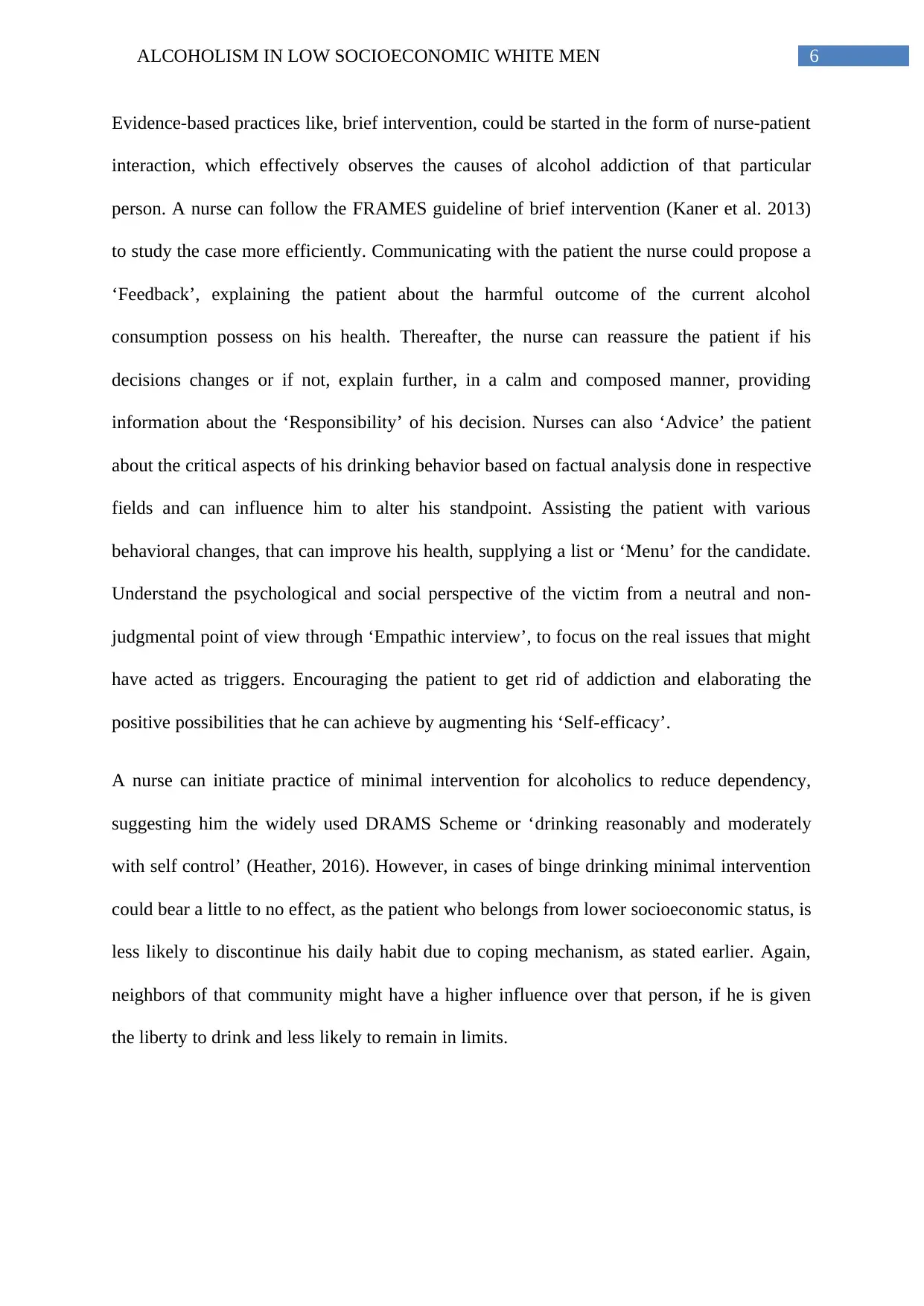
6ALCOHOLISM IN LOW SOCIOECONOMIC WHITE MEN
Evidence-based practices like, brief intervention, could be started in the form of nurse-patient
interaction, which effectively observes the causes of alcohol addiction of that particular
person. A nurse can follow the FRAMES guideline of brief intervention (Kaner et al. 2013)
to study the case more efficiently. Communicating with the patient the nurse could propose a
‘Feedback’, explaining the patient about the harmful outcome of the current alcohol
consumption possess on his health. Thereafter, the nurse can reassure the patient if his
decisions changes or if not, explain further, in a calm and composed manner, providing
information about the ‘Responsibility’ of his decision. Nurses can also ‘Advice’ the patient
about the critical aspects of his drinking behavior based on factual analysis done in respective
fields and can influence him to alter his standpoint. Assisting the patient with various
behavioral changes, that can improve his health, supplying a list or ‘Menu’ for the candidate.
Understand the psychological and social perspective of the victim from a neutral and non-
judgmental point of view through ‘Empathic interview’, to focus on the real issues that might
have acted as triggers. Encouraging the patient to get rid of addiction and elaborating the
positive possibilities that he can achieve by augmenting his ‘Self-efficacy’.
A nurse can initiate practice of minimal intervention for alcoholics to reduce dependency,
suggesting him the widely used DRAMS Scheme or ‘drinking reasonably and moderately
with self control’ (Heather, 2016). However, in cases of binge drinking minimal intervention
could bear a little to no effect, as the patient who belongs from lower socioeconomic status, is
less likely to discontinue his daily habit due to coping mechanism, as stated earlier. Again,
neighbors of that community might have a higher influence over that person, if he is given
the liberty to drink and less likely to remain in limits.
Evidence-based practices like, brief intervention, could be started in the form of nurse-patient
interaction, which effectively observes the causes of alcohol addiction of that particular
person. A nurse can follow the FRAMES guideline of brief intervention (Kaner et al. 2013)
to study the case more efficiently. Communicating with the patient the nurse could propose a
‘Feedback’, explaining the patient about the harmful outcome of the current alcohol
consumption possess on his health. Thereafter, the nurse can reassure the patient if his
decisions changes or if not, explain further, in a calm and composed manner, providing
information about the ‘Responsibility’ of his decision. Nurses can also ‘Advice’ the patient
about the critical aspects of his drinking behavior based on factual analysis done in respective
fields and can influence him to alter his standpoint. Assisting the patient with various
behavioral changes, that can improve his health, supplying a list or ‘Menu’ for the candidate.
Understand the psychological and social perspective of the victim from a neutral and non-
judgmental point of view through ‘Empathic interview’, to focus on the real issues that might
have acted as triggers. Encouraging the patient to get rid of addiction and elaborating the
positive possibilities that he can achieve by augmenting his ‘Self-efficacy’.
A nurse can initiate practice of minimal intervention for alcoholics to reduce dependency,
suggesting him the widely used DRAMS Scheme or ‘drinking reasonably and moderately
with self control’ (Heather, 2016). However, in cases of binge drinking minimal intervention
could bear a little to no effect, as the patient who belongs from lower socioeconomic status, is
less likely to discontinue his daily habit due to coping mechanism, as stated earlier. Again,
neighbors of that community might have a higher influence over that person, if he is given
the liberty to drink and less likely to remain in limits.
Paraphrase This Document
Need a fresh take? Get an instant paraphrase of this document with our AI Paraphraser
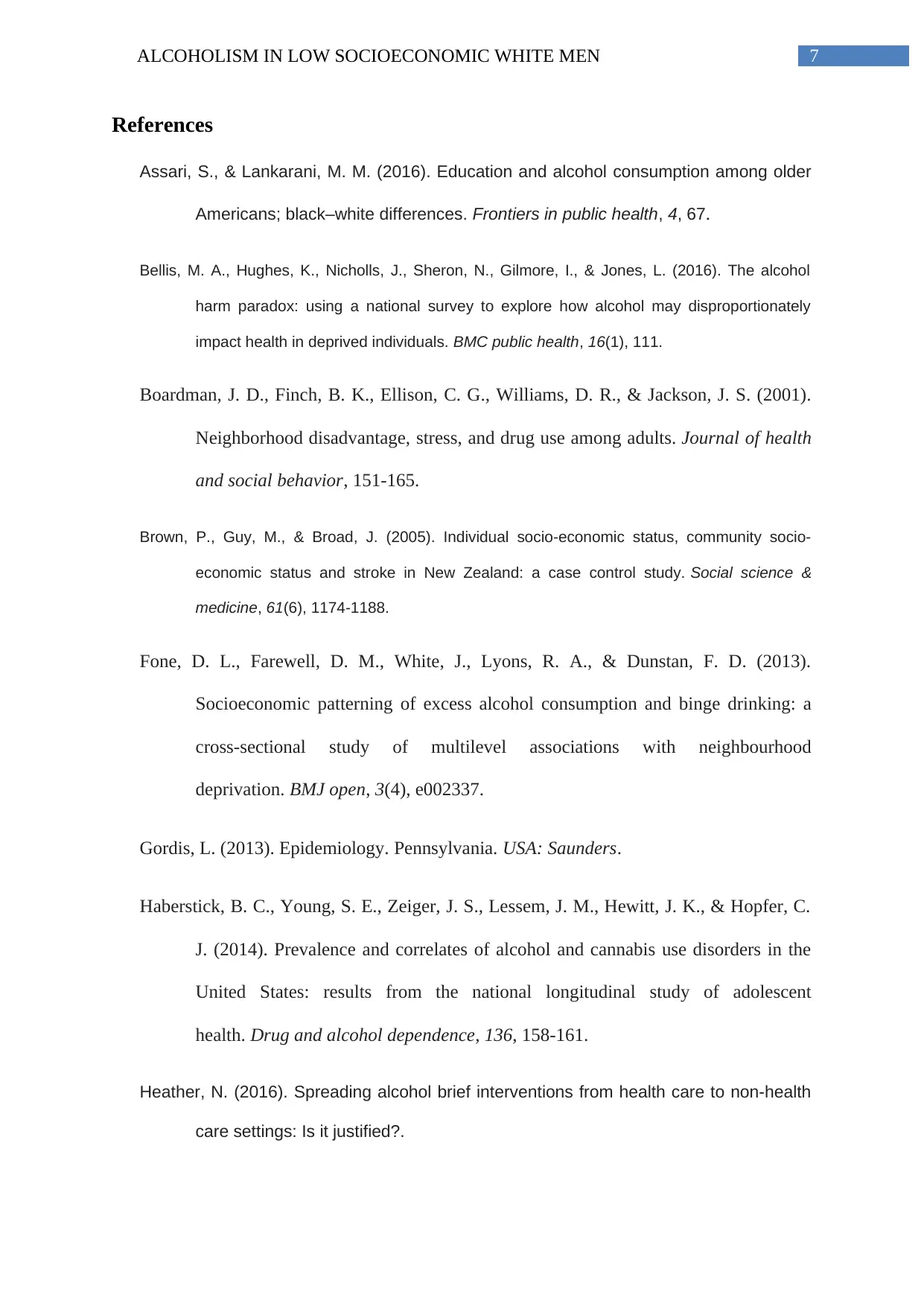
7ALCOHOLISM IN LOW SOCIOECONOMIC WHITE MEN
References
Assari, S., & Lankarani, M. M. (2016). Education and alcohol consumption among older
Americans; black–white differences. Frontiers in public health, 4, 67.
Bellis, M. A., Hughes, K., Nicholls, J., Sheron, N., Gilmore, I., & Jones, L. (2016). The alcohol
harm paradox: using a national survey to explore how alcohol may disproportionately
impact health in deprived individuals. BMC public health, 16(1), 111.
Boardman, J. D., Finch, B. K., Ellison, C. G., Williams, D. R., & Jackson, J. S. (2001).
Neighborhood disadvantage, stress, and drug use among adults. Journal of health
and social behavior, 151-165.
Brown, P., Guy, M., & Broad, J. (2005). Individual socio-economic status, community socio-
economic status and stroke in New Zealand: a case control study. Social science &
medicine, 61(6), 1174-1188.
Fone, D. L., Farewell, D. M., White, J., Lyons, R. A., & Dunstan, F. D. (2013).
Socioeconomic patterning of excess alcohol consumption and binge drinking: a
cross-sectional study of multilevel associations with neighbourhood
deprivation. BMJ open, 3(4), e002337.
Gordis, L. (2013). Epidemiology. Pennsylvania. USA: Saunders.
Haberstick, B. C., Young, S. E., Zeiger, J. S., Lessem, J. M., Hewitt, J. K., & Hopfer, C.
J. (2014). Prevalence and correlates of alcohol and cannabis use disorders in the
United States: results from the national longitudinal study of adolescent
health. Drug and alcohol dependence, 136, 158-161.
Heather, N. (2016). Spreading alcohol brief interventions from health care to non-health
care settings: Is it justified?.
References
Assari, S., & Lankarani, M. M. (2016). Education and alcohol consumption among older
Americans; black–white differences. Frontiers in public health, 4, 67.
Bellis, M. A., Hughes, K., Nicholls, J., Sheron, N., Gilmore, I., & Jones, L. (2016). The alcohol
harm paradox: using a national survey to explore how alcohol may disproportionately
impact health in deprived individuals. BMC public health, 16(1), 111.
Boardman, J. D., Finch, B. K., Ellison, C. G., Williams, D. R., & Jackson, J. S. (2001).
Neighborhood disadvantage, stress, and drug use among adults. Journal of health
and social behavior, 151-165.
Brown, P., Guy, M., & Broad, J. (2005). Individual socio-economic status, community socio-
economic status and stroke in New Zealand: a case control study. Social science &
medicine, 61(6), 1174-1188.
Fone, D. L., Farewell, D. M., White, J., Lyons, R. A., & Dunstan, F. D. (2013).
Socioeconomic patterning of excess alcohol consumption and binge drinking: a
cross-sectional study of multilevel associations with neighbourhood
deprivation. BMJ open, 3(4), e002337.
Gordis, L. (2013). Epidemiology. Pennsylvania. USA: Saunders.
Haberstick, B. C., Young, S. E., Zeiger, J. S., Lessem, J. M., Hewitt, J. K., & Hopfer, C.
J. (2014). Prevalence and correlates of alcohol and cannabis use disorders in the
United States: results from the national longitudinal study of adolescent
health. Drug and alcohol dependence, 136, 158-161.
Heather, N. (2016). Spreading alcohol brief interventions from health care to non-health
care settings: Is it justified?.
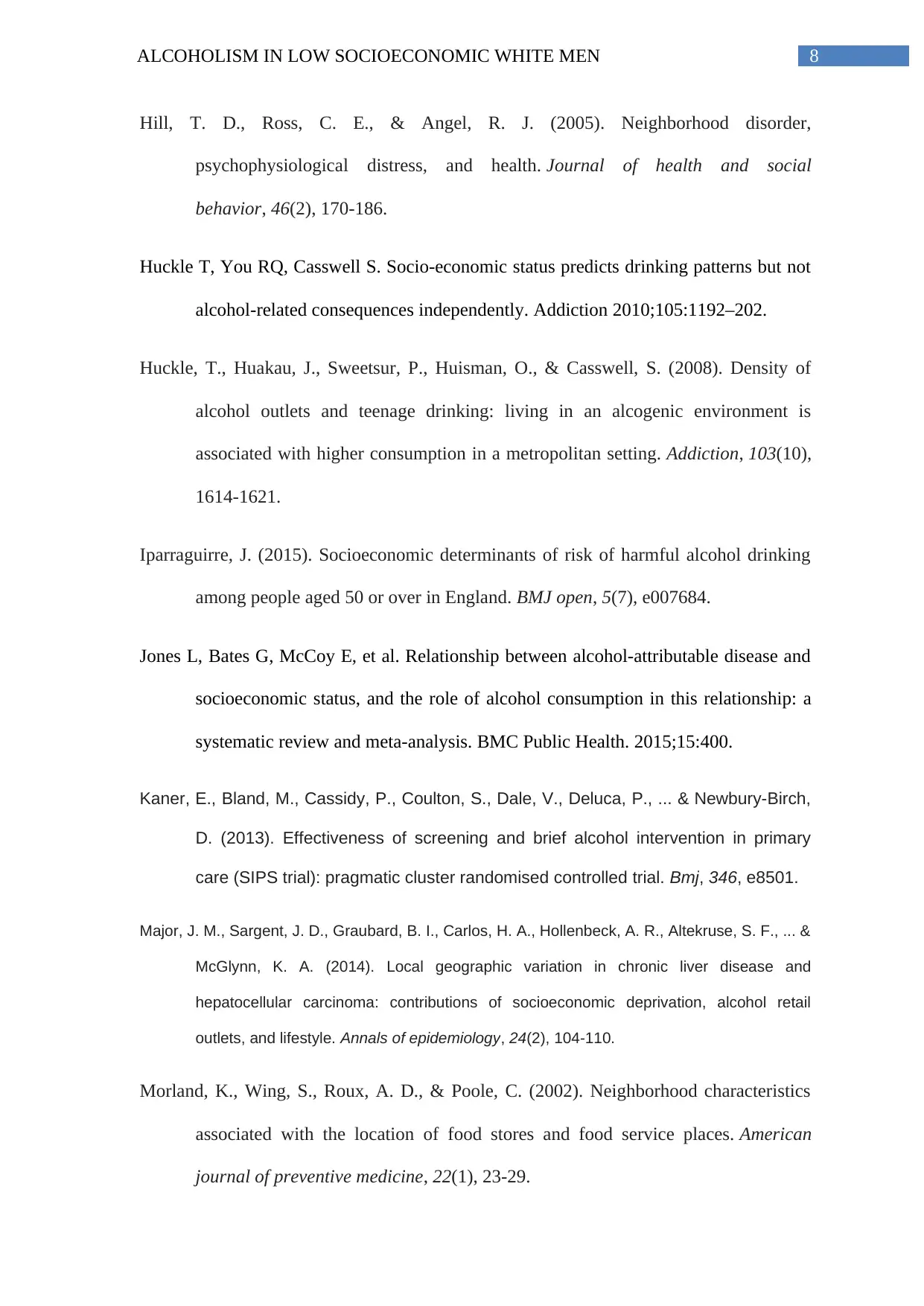
8ALCOHOLISM IN LOW SOCIOECONOMIC WHITE MEN
Hill, T. D., Ross, C. E., & Angel, R. J. (2005). Neighborhood disorder,
psychophysiological distress, and health. Journal of health and social
behavior, 46(2), 170-186.
Huckle T, You RQ, Casswell S. Socio-economic status predicts drinking patterns but not
alcohol-related consequences independently. Addiction 2010;105:1192–202.
Huckle, T., Huakau, J., Sweetsur, P., Huisman, O., & Casswell, S. (2008). Density of
alcohol outlets and teenage drinking: living in an alcogenic environment is
associated with higher consumption in a metropolitan setting. Addiction, 103(10),
1614-1621.
Iparraguirre, J. (2015). Socioeconomic determinants of risk of harmful alcohol drinking
among people aged 50 or over in England. BMJ open, 5(7), e007684.
Jones L, Bates G, McCoy E, et al. Relationship between alcohol-attributable disease and
socioeconomic status, and the role of alcohol consumption in this relationship: a
systematic review and meta-analysis. BMC Public Health. 2015;15:400.
Kaner, E., Bland, M., Cassidy, P., Coulton, S., Dale, V., Deluca, P., ... & Newbury-Birch,
D. (2013). Effectiveness of screening and brief alcohol intervention in primary
care (SIPS trial): pragmatic cluster randomised controlled trial. Bmj, 346, e8501.
Major, J. M., Sargent, J. D., Graubard, B. I., Carlos, H. A., Hollenbeck, A. R., Altekruse, S. F., ... &
McGlynn, K. A. (2014). Local geographic variation in chronic liver disease and
hepatocellular carcinoma: contributions of socioeconomic deprivation, alcohol retail
outlets, and lifestyle. Annals of epidemiology, 24(2), 104-110.
Morland, K., Wing, S., Roux, A. D., & Poole, C. (2002). Neighborhood characteristics
associated with the location of food stores and food service places. American
journal of preventive medicine, 22(1), 23-29.
Hill, T. D., Ross, C. E., & Angel, R. J. (2005). Neighborhood disorder,
psychophysiological distress, and health. Journal of health and social
behavior, 46(2), 170-186.
Huckle T, You RQ, Casswell S. Socio-economic status predicts drinking patterns but not
alcohol-related consequences independently. Addiction 2010;105:1192–202.
Huckle, T., Huakau, J., Sweetsur, P., Huisman, O., & Casswell, S. (2008). Density of
alcohol outlets and teenage drinking: living in an alcogenic environment is
associated with higher consumption in a metropolitan setting. Addiction, 103(10),
1614-1621.
Iparraguirre, J. (2015). Socioeconomic determinants of risk of harmful alcohol drinking
among people aged 50 or over in England. BMJ open, 5(7), e007684.
Jones L, Bates G, McCoy E, et al. Relationship between alcohol-attributable disease and
socioeconomic status, and the role of alcohol consumption in this relationship: a
systematic review and meta-analysis. BMC Public Health. 2015;15:400.
Kaner, E., Bland, M., Cassidy, P., Coulton, S., Dale, V., Deluca, P., ... & Newbury-Birch,
D. (2013). Effectiveness of screening and brief alcohol intervention in primary
care (SIPS trial): pragmatic cluster randomised controlled trial. Bmj, 346, e8501.
Major, J. M., Sargent, J. D., Graubard, B. I., Carlos, H. A., Hollenbeck, A. R., Altekruse, S. F., ... &
McGlynn, K. A. (2014). Local geographic variation in chronic liver disease and
hepatocellular carcinoma: contributions of socioeconomic deprivation, alcohol retail
outlets, and lifestyle. Annals of epidemiology, 24(2), 104-110.
Morland, K., Wing, S., Roux, A. D., & Poole, C. (2002). Neighborhood characteristics
associated with the location of food stores and food service places. American
journal of preventive medicine, 22(1), 23-29.
⊘ This is a preview!⊘
Do you want full access?
Subscribe today to unlock all pages.

Trusted by 1+ million students worldwide
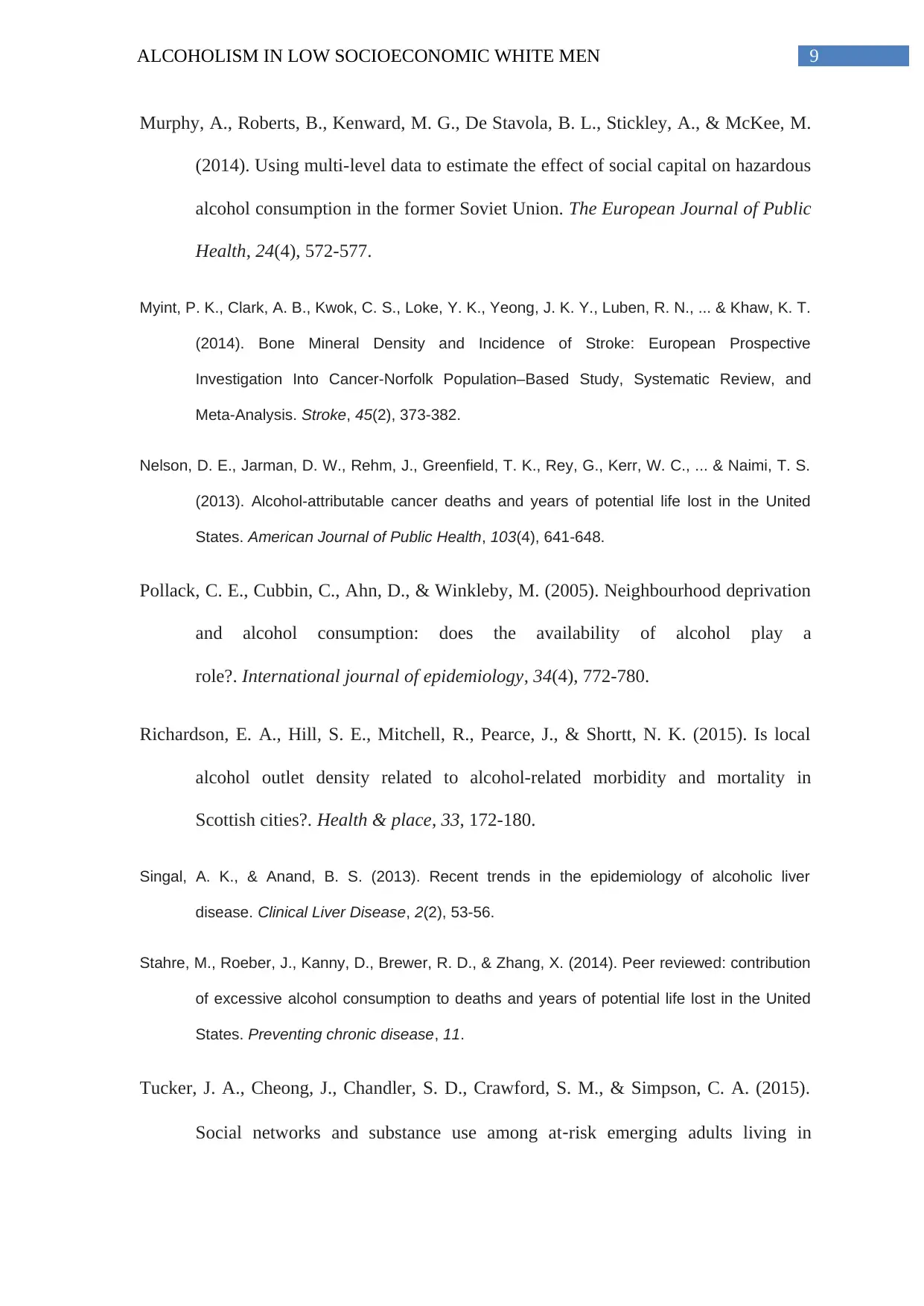
9ALCOHOLISM IN LOW SOCIOECONOMIC WHITE MEN
Murphy, A., Roberts, B., Kenward, M. G., De Stavola, B. L., Stickley, A., & McKee, M.
(2014). Using multi-level data to estimate the effect of social capital on hazardous
alcohol consumption in the former Soviet Union. The European Journal of Public
Health, 24(4), 572-577.
Myint, P. K., Clark, A. B., Kwok, C. S., Loke, Y. K., Yeong, J. K. Y., Luben, R. N., ... & Khaw, K. T.
(2014). Bone Mineral Density and Incidence of Stroke: European Prospective
Investigation Into Cancer-Norfolk Population–Based Study, Systematic Review, and
Meta-Analysis. Stroke, 45(2), 373-382.
Nelson, D. E., Jarman, D. W., Rehm, J., Greenfield, T. K., Rey, G., Kerr, W. C., ... & Naimi, T. S.
(2013). Alcohol-attributable cancer deaths and years of potential life lost in the United
States. American Journal of Public Health, 103(4), 641-648.
Pollack, C. E., Cubbin, C., Ahn, D., & Winkleby, M. (2005). Neighbourhood deprivation
and alcohol consumption: does the availability of alcohol play a
role?. International journal of epidemiology, 34(4), 772-780.
Richardson, E. A., Hill, S. E., Mitchell, R., Pearce, J., & Shortt, N. K. (2015). Is local
alcohol outlet density related to alcohol-related morbidity and mortality in
Scottish cities?. Health & place, 33, 172-180.
Singal, A. K., & Anand, B. S. (2013). Recent trends in the epidemiology of alcoholic liver
disease. Clinical Liver Disease, 2(2), 53-56.
Stahre, M., Roeber, J., Kanny, D., Brewer, R. D., & Zhang, X. (2014). Peer reviewed: contribution
of excessive alcohol consumption to deaths and years of potential life lost in the United
States. Preventing chronic disease, 11.
Tucker, J. A., Cheong, J., Chandler, S. D., Crawford, S. M., & Simpson, C. A. (2015).
Social networks and substance use among at‐risk emerging adults living in
Murphy, A., Roberts, B., Kenward, M. G., De Stavola, B. L., Stickley, A., & McKee, M.
(2014). Using multi-level data to estimate the effect of social capital on hazardous
alcohol consumption in the former Soviet Union. The European Journal of Public
Health, 24(4), 572-577.
Myint, P. K., Clark, A. B., Kwok, C. S., Loke, Y. K., Yeong, J. K. Y., Luben, R. N., ... & Khaw, K. T.
(2014). Bone Mineral Density and Incidence of Stroke: European Prospective
Investigation Into Cancer-Norfolk Population–Based Study, Systematic Review, and
Meta-Analysis. Stroke, 45(2), 373-382.
Nelson, D. E., Jarman, D. W., Rehm, J., Greenfield, T. K., Rey, G., Kerr, W. C., ... & Naimi, T. S.
(2013). Alcohol-attributable cancer deaths and years of potential life lost in the United
States. American Journal of Public Health, 103(4), 641-648.
Pollack, C. E., Cubbin, C., Ahn, D., & Winkleby, M. (2005). Neighbourhood deprivation
and alcohol consumption: does the availability of alcohol play a
role?. International journal of epidemiology, 34(4), 772-780.
Richardson, E. A., Hill, S. E., Mitchell, R., Pearce, J., & Shortt, N. K. (2015). Is local
alcohol outlet density related to alcohol-related morbidity and mortality in
Scottish cities?. Health & place, 33, 172-180.
Singal, A. K., & Anand, B. S. (2013). Recent trends in the epidemiology of alcoholic liver
disease. Clinical Liver Disease, 2(2), 53-56.
Stahre, M., Roeber, J., Kanny, D., Brewer, R. D., & Zhang, X. (2014). Peer reviewed: contribution
of excessive alcohol consumption to deaths and years of potential life lost in the United
States. Preventing chronic disease, 11.
Tucker, J. A., Cheong, J., Chandler, S. D., Crawford, S. M., & Simpson, C. A. (2015).
Social networks and substance use among at‐risk emerging adults living in
Paraphrase This Document
Need a fresh take? Get an instant paraphrase of this document with our AI Paraphraser
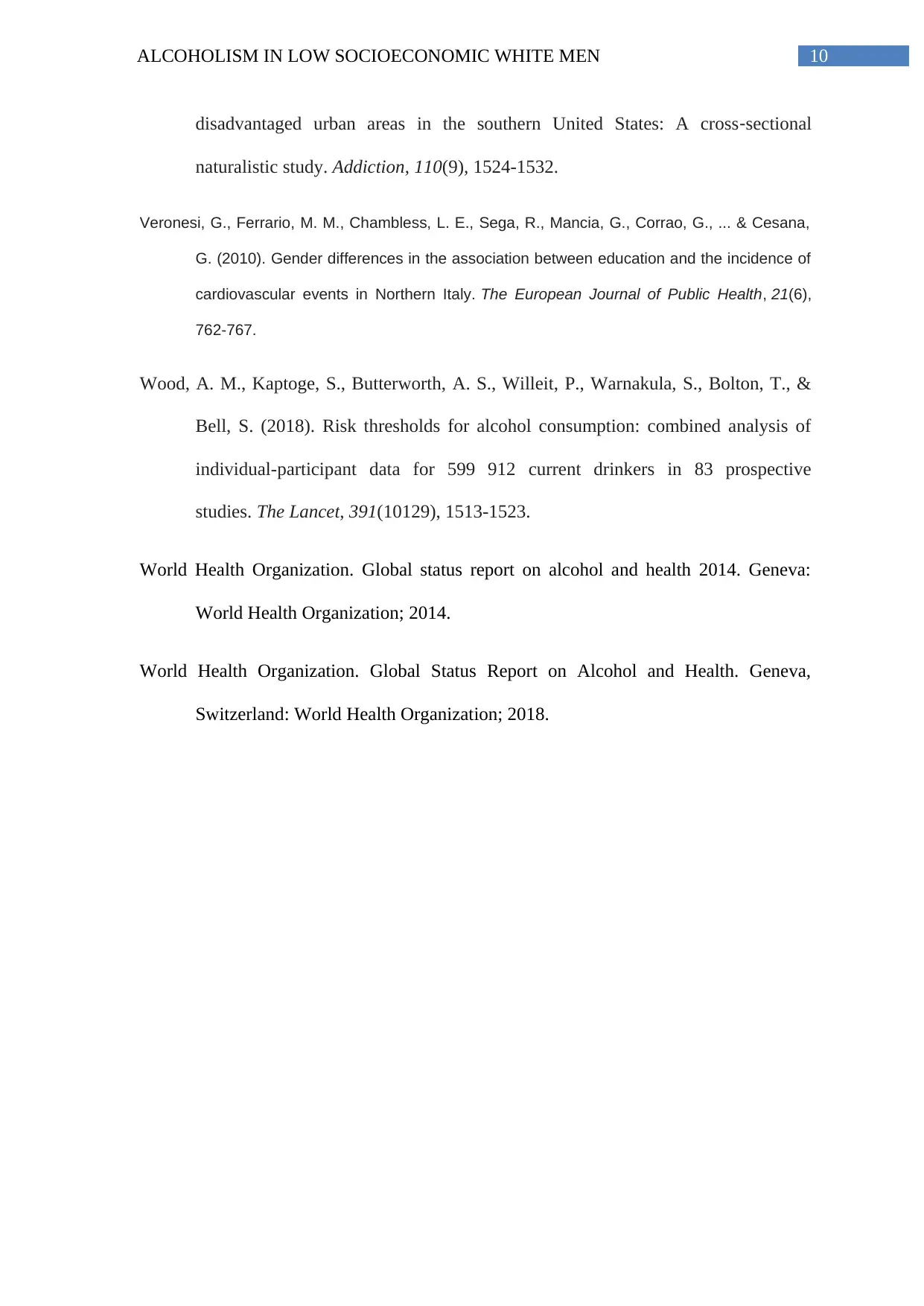
10ALCOHOLISM IN LOW SOCIOECONOMIC WHITE MEN
disadvantaged urban areas in the southern United States: A cross‐sectional
naturalistic study. Addiction, 110(9), 1524-1532.
Veronesi, G., Ferrario, M. M., Chambless, L. E., Sega, R., Mancia, G., Corrao, G., ... & Cesana,
G. (2010). Gender differences in the association between education and the incidence of
cardiovascular events in Northern Italy. The European Journal of Public Health, 21(6),
762-767.
Wood, A. M., Kaptoge, S., Butterworth, A. S., Willeit, P., Warnakula, S., Bolton, T., &
Bell, S. (2018). Risk thresholds for alcohol consumption: combined analysis of
individual-participant data for 599 912 current drinkers in 83 prospective
studies. The Lancet, 391(10129), 1513-1523.
World Health Organization. Global status report on alcohol and health 2014. Geneva:
World Health Organization; 2014.
World Health Organization. Global Status Report on Alcohol and Health. Geneva,
Switzerland: World Health Organization; 2018.
disadvantaged urban areas in the southern United States: A cross‐sectional
naturalistic study. Addiction, 110(9), 1524-1532.
Veronesi, G., Ferrario, M. M., Chambless, L. E., Sega, R., Mancia, G., Corrao, G., ... & Cesana,
G. (2010). Gender differences in the association between education and the incidence of
cardiovascular events in Northern Italy. The European Journal of Public Health, 21(6),
762-767.
Wood, A. M., Kaptoge, S., Butterworth, A. S., Willeit, P., Warnakula, S., Bolton, T., &
Bell, S. (2018). Risk thresholds for alcohol consumption: combined analysis of
individual-participant data for 599 912 current drinkers in 83 prospective
studies. The Lancet, 391(10129), 1513-1523.
World Health Organization. Global status report on alcohol and health 2014. Geneva:
World Health Organization; 2014.
World Health Organization. Global Status Report on Alcohol and Health. Geneva,
Switzerland: World Health Organization; 2018.
1 out of 11
Related Documents
Your All-in-One AI-Powered Toolkit for Academic Success.
+13062052269
info@desklib.com
Available 24*7 on WhatsApp / Email
![[object Object]](/_next/static/media/star-bottom.7253800d.svg)
Unlock your academic potential
Copyright © 2020–2025 A2Z Services. All Rights Reserved. Developed and managed by ZUCOL.





